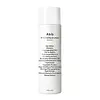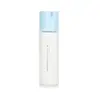What's inside
What's inside
 Key Ingredients
Key Ingredients

 Benefits
Benefits

 Concerns
Concerns

 Ingredients Side-by-side
Ingredients Side-by-side

Sea Water
HumectantGlycerin
HumectantButylene Glycol
HumectantHydrogenated Poly(C6-14 Olefin)
EmollientDicaprylyl Carbonate
EmollientPentylene Glycol
Skin ConditioningCetearyl Alcohol
Emollient1,2-Hexanediol
Skin ConditioningHydrolyzed Hibiscus Esculentus Extract
Skin ConditioningLupinus Albus Seed Extract
Skin ConditioningPEG-25 Moringa Glycerides
EmollientPouteria Lucuma Seed Extract
Skin ConditioningHydrolyzed Vegetable Protein
Skin ConditioningZanthoxylum Piperitum Fruit Extract
Skin ConditioningHouttuynia Cordata Extract
Skin ConditioningSodium Hyaluronate Crosspolymer
HumectantHydrolyzed Glycosaminoglycans
HumectantRosa Multiflora Fruit Extract
MaskingSodium Hyaluronate
HumectantChrysanthemum Coccineum Flower Extract
Skin ConditioningHydrolyzed Hyaluronic Acid
HumectantEucalyptus Citriodora Oil
MaskingHyaluronic Acid
HumectantRaspberry Ketone
MaskingPanthenol
Skin ConditioningSilica
AbrasivePolyglyceryl-3 Methylglucose Distearate
EmulsifyingWater
Skin ConditioningGlyceryl Stearate
EmollientVinyldimethicone
Caprylyl Glycol
EmollientCetearyl Glucoside
EmulsifyingHydroxyethyl Acrylate/Sodium Acryloyldimethyl Taurate Copolymer
Emulsion StabilisingEthylhexylglycerin
Skin ConditioningDipotassium Glycyrrhizate
HumectantTromethamine
BufferingMadecassoside
AntioxidantMaltodextrin
AbsorbentPropanediol
SolventBenzyl Glycol
SolventGlyceryl Caprylate
EmollientCarbomer
Emulsion StabilisingDisodium EDTA
Sea Water, Glycerin, Butylene Glycol, Hydrogenated Poly(C6-14 Olefin), Dicaprylyl Carbonate, Pentylene Glycol, Cetearyl Alcohol, 1,2-Hexanediol, Hydrolyzed Hibiscus Esculentus Extract, Lupinus Albus Seed Extract, PEG-25 Moringa Glycerides, Pouteria Lucuma Seed Extract, Hydrolyzed Vegetable Protein, Zanthoxylum Piperitum Fruit Extract, Houttuynia Cordata Extract, Sodium Hyaluronate Crosspolymer, Hydrolyzed Glycosaminoglycans, Rosa Multiflora Fruit Extract, Sodium Hyaluronate, Chrysanthemum Coccineum Flower Extract, Hydrolyzed Hyaluronic Acid, Eucalyptus Citriodora Oil, Hyaluronic Acid, Raspberry Ketone, Panthenol, Silica, Polyglyceryl-3 Methylglucose Distearate, Water, Glyceryl Stearate, Vinyldimethicone, Caprylyl Glycol, Cetearyl Glucoside, Hydroxyethyl Acrylate/Sodium Acryloyldimethyl Taurate Copolymer, Ethylhexylglycerin, Dipotassium Glycyrrhizate, Tromethamine, Madecassoside, Maltodextrin, Propanediol, Benzyl Glycol, Glyceryl Caprylate, Carbomer, Disodium EDTA
Water
Skin ConditioningButylene Glycol
HumectantHydrogenated Poly(C6-14 Olefin)
EmollientCetyl Ethylhexanoate
EmollientBis-Hydroxyethoxypropyl Dimethicone
EmollientCaprylic/Capric Triglyceride
MaskingGlycerin
HumectantSucrose Stearate
Emollient1,2-Hexanediol
Skin ConditioningDiisostearyl Malate
EmollientButyrospermum Parkii Butter
Skin ConditioningGlyceryl Stearate
EmollientCetearyl Alcohol
EmollientPanthenol
Skin ConditioningStearic Acid
CleansingPalmitic Acid
EmollientPropanediol
SolventNiacinamide
SmoothingCarbomer
Emulsion StabilisingParfum
MaskingCaprylyl Glycol
EmollientTromethamine
BufferingDextrin
AbsorbentEthylhexylglycerin
Skin ConditioningDisodium EDTA
Hydrolyzed Hyaluronic Acid
HumectantBeta-Glucan
Skin ConditioningMyristic Acid
CleansingArachidic Acid
CleansingLactobacillus Ferment Lysate
Skin ConditioningTocopherol
AntioxidantUndaria Pinnatifida Extract
Skin ConditioningWater, Butylene Glycol, Hydrogenated Poly(C6-14 Olefin), Cetyl Ethylhexanoate, Bis-Hydroxyethoxypropyl Dimethicone, Caprylic/Capric Triglyceride, Glycerin, Sucrose Stearate, 1,2-Hexanediol, Diisostearyl Malate, Butyrospermum Parkii Butter, Glyceryl Stearate, Cetearyl Alcohol, Panthenol, Stearic Acid, Palmitic Acid, Propanediol, Niacinamide, Carbomer, Parfum, Caprylyl Glycol, Tromethamine, Dextrin, Ethylhexylglycerin, Disodium EDTA, Hydrolyzed Hyaluronic Acid, Beta-Glucan, Myristic Acid, Arachidic Acid, Lactobacillus Ferment Lysate, Tocopherol, Undaria Pinnatifida Extract
 Reviews
Reviews

Ingredients Explained
These ingredients are found in both products.
Ingredients higher up in an ingredient list are typically present in a larger amount.
1,2-Hexanediol is a synthetic liquid and another multi-functional powerhouse.
It is a:
- Humectant, drawing moisture into the skin
- Emollient, helping to soften skin
- Solvent, dispersing and stabilizing formulas
- Preservative booster, enhancing the antimicrobial activity of other preservatives
Butylene Glycol (or BG) is used within cosmetic products for a few different reasons:
Overall, Butylene Glycol is a safe and well-rounded ingredient that works well with other ingredients.
Though this ingredient works well with most skin types, some people with sensitive skin may experience a reaction such as allergic rashes, closed comedones, or itchiness.
Learn more about Butylene GlycolCaprylyl Glycol is a humectant and emollient, meaning it attracts and preserves moisture.
It is a common ingredient in many products, especially those designed to hydrate skin. The primary benefits are retaining moisture, skin softening, and promoting a healthy skin barrier.
Though Caprylyl Glycol is an alcohol derived from fatty acids, it is not the kind that can dry out skin.
This ingredient is also used as a preservative to extend the life of products. It has slight antimicrobial properties.
Learn more about Caprylyl GlycolCarbomer is a polymer of acrylic acid. Its main role is to create a gel consistency.
A high amount of carbomer can cause pilling or balling up of products. Don't worry, most products contain 1% or less of carbomer.
Cetearyl alcohol is a mixture of two fatty alcohols: cetyl alcohol and stearyl alcohol. It is mainly used as an emulsifier. Emulsifiers help prevent the separation of oils and products. Due to its composition, it can also be used to thicken a product or help create foam.
Cetearyl alcohol is an emollient. Emollients help soothe and hydrate the skin by trapping moisture.
Studies show Cetearyl alcohol is non-toxic and non-irritating. The FDA allows products labeled "alcohol-free" to have fatty alcohols.
This ingredient is usually derived from plant oils such as palm, vegetable, or coconut oils. There is debate on whether this ingredient will cause acne.
Due to the fatty acid base, this ingredient may not be Malassezia folliculitis safe.
Learn more about Cetearyl AlcoholDisodium EDTA plays a role in making products more stable by aiding other preservatives.
It is a chelating agent, meaning it neutralizes metal ions that may be found in a product.
Disodium EDTA is a salt of edetic acid and is found to be safe in cosmetic ingredients.
Learn more about Disodium EDTAEthylhexylglycerin (we can't pronounce this either) is commonly used as a preservative and skin softener. It is derived from glyceryl.
You might see Ethylhexylglycerin often paired with other preservatives such as phenoxyethanol. Ethylhexylglycerin has been found to increase the effectiveness of these other preservatives.
Glycerin is already naturally found in your skin. It helps moisturize and protect your skin.
A study from 2016 found glycerin to be more effective as a humectant than AHAs and hyaluronic acid.
As a humectant, it helps the skin stay hydrated by pulling moisture to your skin. The low molecular weight of glycerin allows it to pull moisture into the deeper layers of your skin.
Hydrated skin improves your skin barrier; Your skin barrier helps protect against irritants and bacteria.
Glycerin has also been found to have antimicrobial and antiviral properties. Due to these properties, glycerin is often used in wound and burn treatments.
In cosmetics, glycerin is usually derived from plants such as soybean or palm. However, it can also be sourced from animals, such as tallow or animal fat.
This ingredient is organic, colorless, odorless, and non-toxic.
Glycerin is the name for this ingredient in American English. British English uses Glycerol/Glycerine.
Learn more about GlycerinGlyceryl Stearate is a mix of glycerin and stearic acid.
It is used to stabilize the mixing of water and oil ingredients. By preventing these ingredients from separating, it can help elongate shelf life. It can also help thicken the product's texture.
As an emollient, it helps soften skin and supports barrier-replenishing ingredients.
In cosmetics, Glyceryl Stearate is often made from vegetable oils or synthetically produced.
This ingredient may not be fungal-acne safe
Fun fact: The human body also creates Glyceryl Stearate naturally.
Learn more about Glyceryl StearateWe don't have a description for Hydrogenated Poly(C6-14 Olefin) yet.
Hydrolyzed Hyaluronic Acid is a form of hyaluronic acid. It is created by the hydrolysis of hyaluronic acid with a high molecular weight. Once created, Hydrolyzed Hyaluronic Acid has a low molecular weight.
Low molecular weight HA has been shown to hydrate and increase elasticity of the skin. Increasing elasticity is also associated with reduction of wrinkle depth.
One study found topical low molecular weight hyaluronic acid may be considered for the treatment of rosacea in the adult population. However, we always recommend speaking with a professional about your skin concerns.
Hyaluronic acids are a humectant. This means they draw moisture from the air. Hyaluronic acids help moisturize, soothe, and protect the skin.
Read more about other common forms of hyaluronic acid:
Learn more about Hydrolyzed Hyaluronic AcidPanthenol is a common ingredient that helps hydrate and soothe the skin. It is found naturally in our skin and hair.
There are two forms of panthenol: D and L.
D-panthenol is also known as dexpanthenol. Most cosmetics use dexpanthenol or a mixture of D and L-panthenol.
Panthenol is famous due to its ability to go deeper into the skin's layers. Using this ingredient has numerous pros (and no cons):
Like hyaluronic acid, panthenol is a humectant. Humectants are able to bind and hold large amounts of water to keep skin hydrated.
This ingredient works well for wound healing. It works by increasing tissue in the wound and helps close open wounds.
Once oxidized, panthenol converts to pantothenic acid. Panthothenic acid is found in all living cells.
This ingredient is also referred to as pro-vitamin B5.
Learn more about PanthenolPropanediol is an all-star ingredient. It softens, hydrates, and smooths the skin.
It’s often used to:
Propanediol is not likely to cause sensitivity and considered safe to use. It is derived from corn or petroleum with a clear color and no scent.
Learn more about PropanediolTromethamine helps balance the pH and improve the texture of a product. It is synthetically created.
As an emulsifier, Tromethamine prevents oil and water ingredients from separating. This helps stabilize the product and elongate a product's shelf life. Tromethamine also makes a product thicker.
Tromethamine helps balance the pH level of a product. Normal pH level of skin is slightly acidic (~4.75-5.5). The acidity of our skin is maintained by our glands and skin biome. Being slightly acidic allows our skin to create an "acid mantle". This acid mantle is a thin barrier that protects our skin from bacteria and contaminants.
Oral Tromethanmine is an anti-inflammatory drug but plays the role of masking, adding fragrance, and/or balancing pH in skincare.
1,3-Propanediol, 2-amino-2-(hydroxymethyl)-
Learn more about TromethamineWater. It's the most common cosmetic ingredient of all. You'll usually see it at the top of ingredient lists, meaning that it makes up the largest part of the product.
So why is it so popular? Water most often acts as a solvent - this means that it helps dissolve other ingredients into the formulation.
You'll also recognize water as that liquid we all need to stay alive. If you see this, drink a glass of water. Stay hydrated!
Learn more about Water